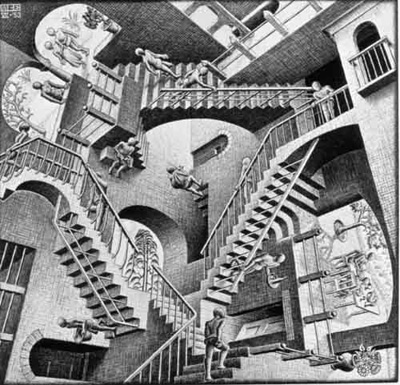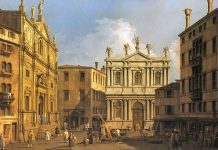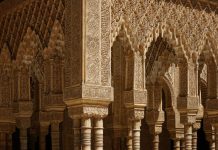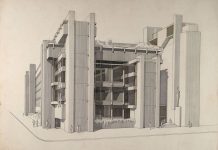The task of creating a new spatial expressiveness is to depict an imaginary (imaginary) space with the help of an object. “For us, however, it is especially important that this artistic image brings with it the destruction of the old concept of monumentality.
The opinion still prevails that art is something that is created forever, and therefore should not be destroyed, be heavy, massive, carved on granite and cast from bronze.
The Eiffel Tower is not monumental, because it was built not for centuries, but in order to attract visitors to the World Exhibition, not a solid mass, but an openwork cone. And so we create a work that, in its full impact, is not directly tangible at all.”
Rotations, shifts, transfers, reflections and other transformations of symmetry create not only static ornamental constructions, varying the position of the fragment, but also with their help the artist conveys the process of movement itself, and then a “moving” graphic or imaginary volume appears. Such an artistic image transforms the familiar concept of monumentality.
Putting the epigraph of the article the words “To be able to see, too, by the way,”art”, Lisitsky confirms his basic idea that the human eye, its culture, its objective creative possibilities create a new vision and image of space in art.
The conventionality of the image suggests a special connection between the psychophysiology of vision and the laws of geometry. An example is M. Escher’s graphic compositions, in which many geometric “mistakes” are intentionally made. But they are the source of the expressiveness of the artist’s works. Geometrically contradictory pictures that distort the topology of the depicted objects are constructed, as a rule, using the technique of rotational symmetry or symmetry of reflection, similarity. The visual space turns out to be stretched or compressed: the artist tries to convey, as it were, the very process of transformation of the rhythmic transition of one form into another form, into a different perspective of perception for the viewer.
The imaginary destruction of the plane is also achieved by V. Vasareli, who uses in his pictorial constructions the features of color perception of symmetrical figures identical in shape. His graphic experiments are adjacent to scientific optics.
Vasareli’s compositions depict such abstract oppositions that are characteristic of the subjects of modern ornament in general: peace-movement, stability-instability, order-disorder, integrity-fragmentation, ascending-descending, completeness-incompleteness, etc.

Ornament, decor has a special role in the design of the relationship between a person and the subject of creativity.
Architectural decor is the sphere where ornamental geometric patterns are represented in all the richness of variations. The literature on this issue is huge. Here we will turn only to the peculiarities of the art of ornament in relation to the theme of the conditional representation of space.
Researchers V. Ya. Beresneva and I. M. Yaglom believe that the transfer of space in ornamental constructions is characterized by an abstract, “perspective alien to perspective”, “the pictorial possibilities of ornament are entirely focused on the reduction of a three-dimensional (or even movable four-dimensional) image to the simplest flat or linear ornamental series. In this respect, the ornaments of the Arabs, the highest masters of geometric ornament in the history of world ornamental art, are no exception (first of all, polygonal ornament is meant): here spatial forms played a role akin to the meaning of color and very far from the tasks of transmitting the three-dimensionality proper. At the same time, the main role in attempts to enrich the visual image with temporary effects of rest, static or, on the contrary, dynamics and movement is played by groups of symmetry of the ornament …”.
From the point of view of ordering, ornaments are classified taking into account the symmetry groups corresponding to their structure. This task is reduced to identifying the so-called crystallographic groups (or discrete groups of movements). Linear crystallographic groups (only 7 of them are known) and flat crystallographic groups (their number is 17) “were found by folk masters of leaf ornament long before these groups were listed by mathematicians and crystallographers. Moreover, in the works of the ornament of sheets, it is possible, apparently, to find the first (and purely experimental) approaches to solving the difficult task of classifying colored ornaments, before which mathematicians are still giving up.”
Ornament is perhaps the most orderly, the most strictly “mathematized” of all the arts. The laws of symmetry and rhythm are revealed in it with such consistency, which is impossible neither in literature, nor in painting, nor in music. The art of ornament can serve as an example of a symmetrically ordered artistic system that has a specific language with a single grammar, a palette of compositional techniques and a variant alphabet reflecting the preferences of different eras and peoples.
The semantics of the ornament is rich in meanings, multi-layered in semantic interpretations of its functions: stylistic, ceremonial, and utilitarian.
For example, the construction of complex geometric grids of medieval oriental ornament required their creators to have thorough mathematical knowledge, despite the fact that the elementary geometric shapes themselves, from which the grids were composed, were revered in traditional culture as sacred.
Perhaps the meaning of the ornament should be sought not in its motives, infinitely peculiar and self-willed, but in their system, their structural orderliness, which in a certain sense turns out to be symbolic.
In the ornament, the ideal, conditional, freed from everyday accidents, the ratio of motives dominates the disorder, the chaotic nature of visual reality. Order, abstracted from the concreteness of the world, constitutes the content of the art of ornament, but it is far from being exhausted by it. However, opinions on this matter are different. Thus, recognizing that the ornament is directly connected with the very foundations of the historical and national worldview, the researcher of the ornament Yu. Nevertheless, Gerchuk believes that the straightforward ideologization of ornamental art in L. Lelekov’s research is excessive. According to this author, “ornamentation was a special case of highly organized ideological and symbolic structures of the medieval worldview. It is permeated by the principle of emphasized organization, evident in other similar systems of visual, speech, religious and philosophical. This principle naturally followed from the universal model of the world, from the image of a hierarchically arranged universe. By placing lions, eagles or vultures among the plants of the magic garden, the carvers of the Dmitrievsky Cathedral, like their Termez or Ani brothers, longed to evoke in the viewer an inner sense of harmony with the universal rhythm of creation.”
Apparently, the creation of ornaments did not require the artist to be directly involved in the philosophical quest of a particular culture, soaring to the heights of the human spirit, as it sometimes did not even require initial literacy. “The strength of this art lies in the fact that such abstract spiritual aspirations and ideas of time are embodied in it mainly intuitively. His affinity with philosophy is hidden from the creators of the ornament, and is revealed to us only in hindsight, in the process of comparative analysis.”




















